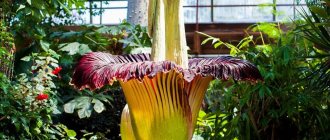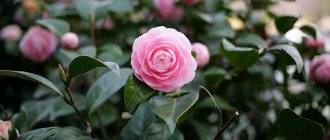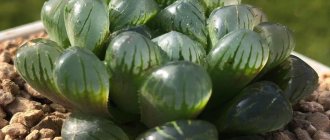How to get a plant?
First you need to find out:
- what conditions does he need;
- How often do you need to water;
- what to feed;
- whether he likes bright sun or not;
- adult size;
- is it not poisonous? Some plants may cause irritation or allergies.
You can buy the specimen you like at a flower shop, but it’s more interesting to grow it yourself from seeds or from cuttings.
A cutting is a small twig or leaf that can be cut from the mother plant and planted in loose soil. For increased humidity, you can cover the cuttings with a jar and spray them 2-3 times a day. After some time, roots will grow on the leaf or twig. Then the jar can be removed.
Seeds are sown in loose soil, watered, and covered with glass or film to maintain moisture. The glass is raised and ventilated several times a day. After the sprout appears, the glass is removed.
In summer, flowers can be planted on the balcony. Typically, annual plants are planted in balcony boxes; in one season they grow, bloom, produce seeds, and then die. They bloom all summer and delight the eye with bright colors.
Lesson summary of the world around us “Indoor plants”
1) Why are indoor plants green all year round?Why do indoor plants remain green all year round? Let's find the answer in the textbook. Open bookmarking tutorial, page 76.
Look at the text below the pictures. Let's read it to find out where indoor plants came to us from. (teacher asks student to read)
So, why do houseplants stay green all year round? (because their homeland is warm countries, they do not need to prepare for winter)
Indeed, in tropical and subtropical forests and deserts it is very warm, therefore the plants that grow there are evergreen. )
Tropical forests are characterized by a hot climate and high humidity.
Close the textbook. Place it on the edge of your desk.
2) The appearance of indoor plants, their role for humans
Guys, where do you think indoor plants come from? Why did they start growing them?
( for beauty, for benefit, for oxygen)
People have been decorating their homes with plants for a long time. This custom originated in countries with cold winters. At first, in winter they began to grow medicinal plants so that they would always be at hand, because at that time there were no pharmacies or other medicines (potions, tablets). Then they began to be grown simply for beauty.
Travelers began to bring plants from different countries, and this is how tropical plants appeared in our homes.
There are special places where plants are grown. Who knows what they are called? ( greenhouse)
Right.
In our city there is a very large place where you can find the rarest and most beautiful plants. Who knows what this place is called?
Guys, what are the benefits of plants in our homes? ( they decorate the house, there are medicinal plants, they purify our air)
Right. Plants produce oxygen necessary for life. This is very important for a person’s life in a big city!
3) Popular indoor plants
What indoor plants do you know?
Who has indoor plants at home? Do you know what they are called?
Do you know the names of the plants that are in our class?
Who prepared a message about indoor plants??
What plants are in front of us? Read the title.
Are you familiar with these plants? Where did you see them?
a) Hippeastrum
Look at the slide, use the atlas to determine the name of this plant?
Guys, what does he look like? Name its distinctive features by looking at the illustration. ( it has large red flowers, a long thick stem, long leaves)
The complex name “Hippeastrum” can be translated as “cavalier with a star”, and this is not surprising. Look at the petals of its flower, their sharp ends resemble the ends of a star. Hippeastrum is native to the tropical forests of South America.
It can be propagated in several ways: by dividing the bulb into parts, planting small onions that were formed from dividing the bulb into parts, and planting seeds.
Have you ever seen this plant? Where?
Is this plant in our class?
b) Saintpaulia (violet)
And this plant is very familiar to all of us. What is it called? ( violet)
Find the image of a violet in the atlas. Look what it's called right? ( saintpaulia)
The scientific name of this plant is Saintpaulia; it is popularly called violet.
So what does this flower look like? ( real frontal form of work; children’s answers: it has fleshy leaves, covered with hairs, many small flowers)
When can it bloom? ( implemented frontal form of work; children’s answers: all year round)
Where is his homeland? ( implemented frontal form of work; children’s answers: Africa)
Imagine, Saintpaulia flew to us from distant Africa and settled in almost every home!
Propagating Saintpaulia is quite simple: you need to take a leaf with a stem, which will be called a cutting, and put it in water. After about two weeks, roots will form on the stem of the leaf, which means it’s time to plant the young plant in the ground.
Is she in our class? Show it.
d) Ficus
Here is another plant that we can often see indoors, at school and at home.
Look in the atlas, what is it called?
What do you know about this plant?
Where did he come from? ( implemented frontal form of work; children’s answers: from India)
Does anyone have a ficus at home? What can you say about him? ( implemented frontal form of work)
Ficus has large, smooth leaves covered with skin. He doesn't like change, so it's better not to disturb him, but to put him in one place. Unlike Saintpaulia, ficus is very picky when it comes to watering: as soon as you miss watering, it begins to shed its leaves.
Reproduction of ficus is more difficult than that of violet. First, from a small piece (the teacher shows the approximate size with his fingers) of the trunk, remove the top layer with a knife until it turns white, then this piece is wrapped in a plastic bag with wet moss inside. After some time, the roots will tear the bag, and then part of the trunk with new roots is cut off from the old plant and planted in a separate pot.
Ficus has a lot of varieties, look, which ones have you seen?
Is there this plant in the class? There are even several species of this plant in our class! Let's put it in the table. (students write down)
e) Sansevieria (Pike tail)
What is the name of this plant? ( implemented frontal form of work; children’s answers: sonsevriere, pike tail)
Find it in the atlas.
What page is it on? ( executive frontal form of work; children’s answers: 28)
Sansevieria (popularly called pike tail) is one of the most popular indoor plants. Why do you think? ( implemented frontal form of work)
Yes, because it is not at all whimsical, and it is very easy to grow.
Is there this plant in the class? ( real frontal form of work; children’s answers: yes) (the teacher takes the plant and puts it on his table)
He flew to our class just like the violet, from distant Africa.
Its leaves are thick, smooth, the ends of the leaves are sharp, you need to be careful with them. (teacher shows the plant and its leaves)
Look how sharp the ends of the leaves are, they are sharp like the teeth of a pike, that’s why it was nicknamed “pike tail”.
How do you think this plant can be propagated? ( implemented frontal form of work)
Sansevieria does not have seeds; to propagate it, you just need to cut off the end of the leaf and plant it in moist soil. We must not forget to water it and then the plant will give roots and new sprouts.
e) Chlorophytum
And this plant is the leader in the popularity of cultivation in schools, kindergartens and at home. It is as unpretentious as sansevieria. Who can tell what it's called? ( implemented frontal form of work; children’s answers: chlorophytum)
On the same page as Sansevieria, find this plant. What does it look like? ( real frontal form of work; children’s answers: it has a lot of green leaves and long branches, leaves at the ends of the branches)
And, indeed, we can see a lot of green leaves, which is how it got its name. Translated from Greek, chlorophytum means green plant. He has long hanging mustaches or arrows, at the ends of which his “babies” grow. To propagate it, you need to carefully cut off the young shoots from the shoot and root them in the ground (plant them) or put them in water until their own roots appear.
Chlorophytum should be watered abundantly and often, and then it will delight the eye with its interesting and bright green leaves. He came to us from Africa too!
Do we have this plant in our class? ( implemented frontal form of work)
Who has it at home?
Have you propagated it? ( implemented frontal form of work)
g) Dracaena
Guys, the next plant looks like a tree. What is it called, who knows? ( implemented frontal form of work; children’s answers: dracaena, palm tree)
It is often called simply a palm tree, but the scientific name for this houseplant is dracaena. Let's turn to the atlas to find out more about this plant. (teacher asks student to read information about dracaena on page 31)
So where does it come from? How high can it grow? ( implemented frontal form of work; children’s answers: Africa, up to 3 meters)
Do we have dracaena in our classroom? Find her. Is she tall or not? ( implemented frontal form of work)
Our dracaena is not very tall yet, but in a few years it may well grow to the very ceiling! Let's write down the name and country in the table.
Look at how it is propagated. To do this, you need to trim the trunk, then cut off the top.
Then, the cuttings need to be placed in water until young roots appear. And then you can safely plant the plant in the ground! Soon young leaves will appear at the end of the trunk.
Where else have you seen this plant? ( implemented frontal form of work)
4) Guess the plant
Now we will work in pairs.
Each pair received an envelope like this (the teacher shows the envelope)
In the envelope you will find a picture of a houseplant.
Get to work. You have 5 minutes to work
( students receive 3 different types of envelopes: calla lily, monstera, bell and a task: insert the missing words; students are given 5 minutes to work)
So, time is up. Let's check.
(pictures appear on the slide that the children had to collect)
6) Caring for indoor plants
So that our flowers do not die, but continue to delight us every day, we must learn to care for them.
How should you care for plants? What are the rules? ( implemented frontal form of work; children’s answers: water)
(a reminder appears on the board)
Guys, I created this care reminder.
Is it correct? Let's read it. (the teacher asks several people to read the points of the memo out loud)
To find out, let's turn to the textbook. Open your textbook to page 78.
Let's read the rules for caring for indoor plants point by point. (the guys compare the points on the board and in the textbook and come to the conclusion that everything is written correctly)
We know the rules of care, let's try to put them into practice.
7) Practical work “Plant care”
Now we will learn how to care for the plant. We have to loosen the soil, spray the plant, wipe the dust from the leaves with a cloth and water our plant.
Look back. (at the end of the class there are 7 indoor plants in pots on newspapers on the tables, next to the plants there are cups of water, sticks for loosening, rags and a spray bottle)
Now I will show you how to care for the plant. (the teacher demonstrates to the children how to loosen the soil, spray the plant, wipe the dust from the leaves and water, the children watch)
Now try it too. The first 4 people go to the first table. Let's see how you remember the order of care . (students complete the task; this happens until all children have participated in practical work)
Some leaves are fleecy and cannot be poured with water or sprayed; dirt must be removed from them with a brush.
(students sit down)
Guys, sometimes when you water a plant, the water passes through the ground very quickly and collects in the pan. When the plant is young, it has very small roots and is unable to get water. Therefore, when planting young plants, drainage is often placed in the pot. This is sand or pebbles. Look what he looks like.
How often do you think plants should be watered? (implemented frontal form of work)
Plants need to be watered every day or every other day; you can determine whether a plant needs watering by simply touching the soil: if it is wet, there is no need to water it. If the plant is mature, it can be watered in a tray. It must always be clean, this is very important!!
Do you think it is necessary to water equally often in winter and summer? Why? (implementation of the front form of work; children’s answers: more often in the summer, because it’s hot, the air is dry)
The main indicator that the plant needs to be replanted is that you can see that it is already cramped in this pot. Sometimes, the roots are even visible above the ground.
So guys, great job! Now you know how to care for a houseplant and can help your mother at home!
Let's put together a care guide. How should you care for the plant? (implemented frontal form of work, students tell everything they have learned, then a reminder appears on the slide, students test themselves)
7) Report on practical work (
Open your notebooks to the page
What needs to be done in it? (implemented frontal form of work; student answers: write about the work completed)
Right. Let's write down what we did with the plant today.
What should we write in the goal? What should we have done? (implemented frontal form of work; student answers: water the plant and loosen the soil)
Write down (slide): plant care
What's next? (implemented frontal form of work; student answers: what did you use?)
What did you use for this? (implemented frontal form of work; student answers: sticks, sprayer, rag, water)
Let's write it down.
Progress. What actions did you perform? (implemented frontal form of work; student answers: loosened the ground, sprayed, wiped the leaves, watered)
Have we achieved our goal? (implemented frontal form of work; student answers: yes)
How can this be written down? (implemented frontal form of work)
Plants received care
Well done. Close your notebooks.
Can a plant communicate with people?
Yes! If you observe an indoor flower, you can see this:
- if it is very dry, the leaves begin to wither and fall off so it asks for watering;
- if the leaves turn yellow, it means there is a lack of some nutrients and additional feeding is needed;
- leaves curl up and are attacked by pests. They can be washed off with soapy water;
- when the leaves are green, elastic, healthy, it means the flower is doing well.
Everyone likes to be loved. So talk to your green friend, treat him with love and attention, and he will definitely shine with happiness and look great.
Here you can find reports on violet, aloe, indoor lemon.
3) Using this information, find the homeland of cacti and begonias in the photographs. Test yourself with. 88
The first photo shows an icy desert. Nothing grows there. On the second we see the usual hot desert. This is the homeland of cacti. The third photo shows a damp, dense forest - this is the homeland of begonia.
Homework
What's growing on the windowsill in your classroom?
Sansevieria, date palm, Chinese rose, and hippeastrum grow on the windowsill in our classroom.
Name a few indoor plants.
Monstera, cyclamen, asparagus, geranium, abutilon, kalanchoe.
How to draw aloe, why I like it
We have aloe growing at home. The juice of this flower is healing. Even ancient people used this plant for medicinal purposes. When I'm sick, my grandmother always treats me with aloe juice. I like this flower because it does not just grow for beauty, but brings benefits to people. When I grow up, I want to become a biologist and study and discover new medicinal plants.
How to draw a geranium, why I like it
On the windowsill of my house there is a bright and colorful plant growing - geranium. Its other name is also very beautiful - pelargonium. It blooms long and profusely. In the autumn, when it is gray and rainy outside, I look at the blooming geraniums, remember the bright summer and my mood lifts.
How to draw a croton, why I like it.
Croton or codiaum is a very unusual flower that grows in our home. Its leaves have a bizarre shape and bright color. Croton leaves remind me of golden autumn, a very beautiful time of year. "Golden Autumn" in a pot on the windowsill at my house - it's so cool!
How to draw a cactus, why I like it
Many people don't like cacti because they are prickly. I like them, I just need to handle them carefully. I take care of my cacti and want to collect a large collection of different cacti. After all, with proper care, cacti bloom very unusually and beautifully!
All answers to workbooks on the world around us, detailed analysis of complex tasks here
Emergency! Hello! My name is Maria, I am the author of the Pushkin website. I hope that my site helps you, in turn I ask for your help. Support the project so that it continues to exist and develop. Every 10 rubles you spend is important. I hope for you. Collection page here
How to draw an orchid, why I like it
My mother is interested in orchids. We have 12 growing at home. They are all different and bloom incredibly beautifully. Orchid flowers are delicate and striking in their beauty. First, the orchid sends out an “arrow”, it grows, buds appear and you look forward to a small miracle. And now the buds open! You can admire the bright orchid flowers endlessly!








